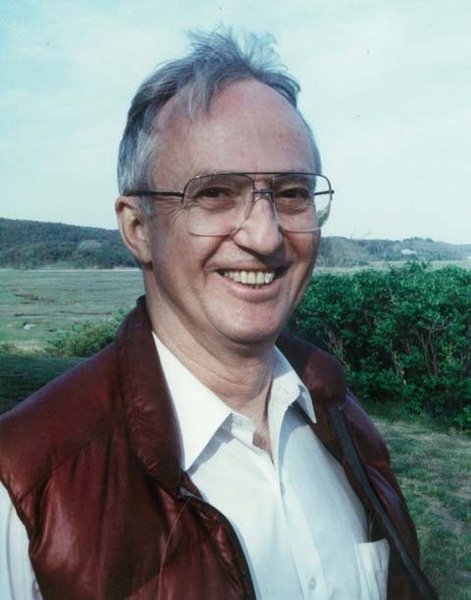Willem Van Rensselaer Malkus, emeritus professor of mathematics at MIT, died in Falmouth, Massachusetts, on Saturday May 28, at the age of 92. He was a professor of applied mathematics at MIT from 1969 until his retirement in 1996.
Malkus was a physical applied mathematician who focused on problems in thermal convection, magnetohydrodynamics, and geophysical fluid dynamics. A pioneer in fluid dynamics, he inspired students and colleagues alike to delve deeply into the important problems of his time.
As a graduate student, Willem worked with the preeminent physicist Enrico Fermi, who convinced him to begin his research career by trying to discover magnetic monopoles. While this was a risky and ultimately unsuccessful venture, it left Malkus with an abiding skepticism that he put to good use throughout his career. Following graduate school, Malkus left particle physics and turned his attention to a more tangible subject — fluid mechanics, where he was particularly interested in its geophysical applications.
Malkus made fundamental contributions to the theory of thermal convection, turbulence, magnetohydrodynamics, elliptical flows, and their applications in geophysics. He was particularly focused on the magnetic dynamo problem, as concerns the manner in which the motion of an electrically conducting fluid can generate a magnetic field. In 1968, he proposed a novel theory for a precessionally-forced geodynamo, well known to workers in the field.
In the early 1960s, Malkus struggled, along with Edward Lorenz, to understand the origins of what is now widely known as “chaos.” With his colleague Louis Howard, he invented a simple mechanical device, known as the “Malkus-Howard-Lorenz Waterwheel,” that realized Lorenz’s famous equations. Malkus joked that Lorenz’s equations much better described his mechanical toy than the phenomenon they were intended to describe, atmospheric convection. Malkus’s waterwheel became a paradigmatic realization of a chaotic system, and is now widely used in the teaching of chaos theory.
Throughout his career, Malkus worked on diverse problems, making decisive and deep contributions to our understanding of a range of subtle phenomena. His work was characterized by a combination of careful experiments and theoretical modeling designed to illustrate fundamental principles. He delighted in variational principles and was always seeking new applications for them, especially in deducing criteria for hydrodynamic stability. His work continues to inspire applied mathematicians, geophysicists, and the wider scientific community.
Malkus was a founding member of the Geophysical Fluid Dynamics (GFD) Program at the Woods Hole Oceanographic Institution in 1959. This program has been hugely influential in growing an entire community of scholars. In 1959, GFD was a new field — but over the years more than 450 student fellows and 1,000 visitors have participated in the program. Malkus was a regular at the GFD summer lectures at Walsh Cottage for almost 50 years. In 2008, the GFD program’s founding members, including George Veronis of Yale University and Louis Howard of MIT and Florida State University, received the Excellence in Geophysical Education Award by the American Geophysical Union.
When he arrived at MIT, Malkus founded the Applied Math Laboratory, where he carried out a variety of fluid mechanics experiments, including seminal experiments on thermal convection and elliptical flows. He recognized the value of an experimental facility to the subject of applied mathematics, and encouraged and supported its use by his students and colleagues.
During his time at MIT, Malkus twice served as chair of the Applied Mathematics Committee: 1977-79 and 1984-87. He was a beloved supervisor of graduate students, many of whom now occupy leading academic positions. They all saw at first-hand how his passion for scientific inquiry burned strongly — remaining undimmed even into his 90s — and were inspired by the high scientific standards he demanded of himself and invariably of any seminar speaker.
He was strongly influenced by his mother, Alida Sims Malkus, who was an accomplished author and daring traveler, and who raised Malkus and his brother alone through the Great Depression. Malkus’ passion for fluid dynamics was matched by a love of sailing in the waters that surround Woods Hole. While sometimes his crew showed reservations, Malkus was always eager to share what strong winds, hard currents, and narrow passages could teach about dynamical systems. In his later years, when his gait on land was unsteady and reaching the boat was a challenge, Malkus persisted and was stable and at ease under sail in Vineyard Sound.
Willem V. R. Malkus was born in Brooklyn, New York, on November 19, 1923. He studied at the University of Michigan and Cornell University, and was admitted to the PhD program in physics at the University of Chicago, to study under Enrico Fermi. Malkus received his PhD in physics in 1950.
He was appointed assistant professor at the University of Chicago from 1950 to 1951 and later joined the staff at the Woods Hole Oceanographic Institute as a research associate from 1951 to 1956, and was promoted to physical oceanographer from 1956 to 1962. From 1958 to 1960, he was jointly appointed professor of oceanography at MIT. In 1960, he joined the faculty at the University of California at Los Angeles as a professor of geophysics and was a professor of geophysics and mathematics there from 1967 to 1969, before joining the applied mathematics faculty at MIT.
Malkus was elected a fellow of the American Academy of Arts and Sciences in 1964. He was also a fellow of the American Physical Society and the American Geophysical Union. He received two Guggenheim Fellowships in 1972 and 1979. In 1972, he was elected a Member of the National Academy of Sciences.
Malkus is survived by his wife of 51 years, Ulla C. Malkus of Falmouth, Massachusetts; children David S. Malkus of Madison, Wisconsin; Steven W. Malkus of Falmouth, Massachusetts; Karen E. Malkus-Benjamin of Brewster, Massachusetts; Per N. Malkus of Carrboro, North Carolina; and grandchildren Christopher B. Malkus, Annelise C. Malkus, Byron F. Malkus, Renata L. Malkus, Michael B. Herrmann, Esme E. Herrmann, and Kira A. Malkus.
A family memorial is under consideration. Further information will be posted on the MIT Department of Mathematics website.






